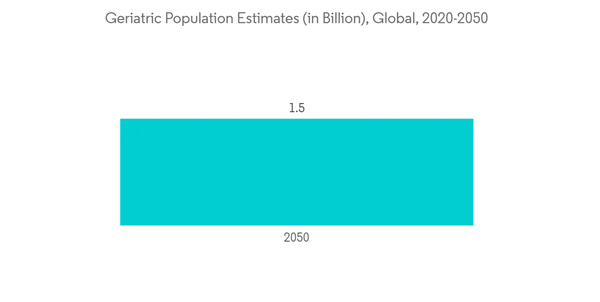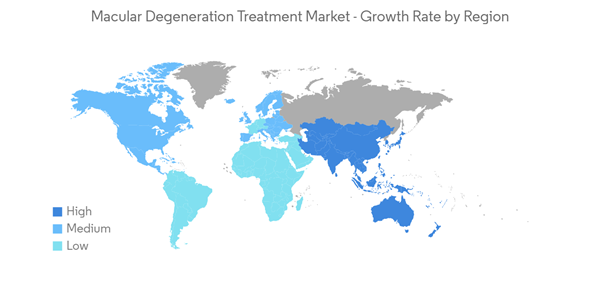The COVID-19 pandemic had potential economic impact and implications for most sectors, including the pharmaceutical and biotech industries. For instance, according to a research study published in the SN Comprehensive Clinical Medicine Journal in October 2020, the number of clinic visits for intravitreal injections (IVI) in the treatment of macular degeneration during one month from March 15 to April 14 of 2020 was compared to a similar time period in each of the last four years. The study demonstrated a decrease in clinic visits for intravitreal injections (IVI) compared with the same 4-week interval in the four previous years, and a total of 636 eyes received injections during a 4-week period of the COVID-19 outbreak in the Retina Clinic, Israel, in 2020, as compared to 995 injections in 2019. However, the easing of norms and the start of vaccination programs led to a recovery in the macular degeneration market.
The major factors attributing to the growth of the macular degeneration treatment market are the increasing burden of retinal disorders, the upsurge in the geriatric population, and an increase in research and development investments.
The increasing burden of retinal disorders is driving the market's growth. For instance, according to a research article published in the British Journal of Ophthalmology in August 2020, in Europe, age-related macular degeneration (AMD) is the main cause of visual impairment and blindness. About 67 million people in Europe are affected by age-related macular degeneration (AMD), and due to population aging, this number is expected to increase by 15% until 2050. As per the statistics, the increasing number of individuals with retinal disorders is directly proportional to market growth. Thus, the increasing burden of such disorders is driving the demand for macular degeneration treatment, which is further contributing to market growth.
Moreover, increasing research and development (R&D) and increasing clinical trials are other major factors for market growth. For instance, in November 2022, 4D Molecular Therapeutics, Inc., a clinical-stage biotherapeutics company harnessing the power of directed evolution for targeted genetic medicines, announced interim clinical data from cohort 1 of the Phase I/II clinical trial of intravitreal 4D-150 for wet AMD. The data focused on safety, tolerability, aflibercept transgene expression, and anti-VEGF clinical activity of the 4D-150 genetic medicine in patients enrolled in Cohort 1. Moreover, in January 2021, Novartis AG started a phase III clinical trial to evaluate the efficacy and safety of brolucizumab in patients with neovascular age-related macular degeneration. Such developments are fueling the growth of the macular degeneration market.
However, the increasing use of off-label drugs and lack of awareness regarding the disease are the major restraints on the growth of the market.
Macular Degeneration Treatment Market Trends
Wet Age-related Macular Degeneration is Expected to Hold Significant Market Share Over the Forecast Period
By type, wet macular degeneration is anticipated to hold a significant share. Wet macular degeneration is the initiation of a typical growth of blood vessels beneath the retina. These overgrown blood vessels drip blood, which impedes the clarity of central vision and leads to macular degeneration.As age-related macular degeneration is the most common cause of severe loss of eyesight among people over 50 years of age, the rising geriatric population all over the world is creating a high level of demand in the wet macular degeneration market. For instance, as per the World Population Prospects 2022, the share of the global population aged 65 years or older is projected to rise from 10% in 2022 to 16% in 2050. By 2050, the number of persons aged 65 or over worldwide is projected to be more than twice the number of children under age 5 and about the same as the number of children under age 12. The above statistics represent the high demand for products for the treatment of wet macular degeneration globally in the future.
Increasing research and development activities in the development of new products are also boosting market growth. For instance, in November 2022, CLS-AX demonstrated positive results in the Phase I/IIa OASIS clinical trial in neovascular wet age-related macular degeneration. CLS-AX (axitinib injectable suspension) met the trial's primary endpoint by demonstrating a positive safety profile at all doses and time points in 27 participants in four cohorts. Such studies are expected to boost the growth of the segment over the forecast period.
The market players adopted various strategies, such as product launches, collaborations, developments, acquisitions, mergers, and expansions, to increase their market share. For instance, in November 2022, STADA Arzneimittel AG and Xbrane Biopharma AB announced that the European Commission granted marketing authorization for Ximlici (ranibizumab), a biosimilar to Genentech's Lucentis. Silica is an anti-VEGF (vascular endothelial growth factor) for the treatment of retinal vascular disorders and has been approved by the European Union (EU) for the treatment of wet age-related macular degeneration (wet AMD). Hence, owing to the factors mentioned above, it is expected to drive the segment's growth over the forecast period.
North America Dominates the Market and is Expected to do Same in the Forecast Period
Some of the factors driving market growth in the North American region include the increasing burden of the geriatric population and age-related macular degeneration, the presence of key market players, and increasing research and development activities.According to a research study published in Nature Medicine in August 2020, patients with age-related macular degeneration (AMD) who become infected with SARS-CoV-2 are at higher risk of developing severe complications, including requiring supplemental oxygen and death. Furthermore, the American Macular Degeneration Foundation (AMDF) in the United States disseminated this information to warn age-related macular degeneration (AMD) patients and eye care practitioners about the potential risk.
Advanced age-related macular degeneration is considered a leading cause of irreversible blindness and visual impairment across the world. Thus, the increasing burden of age-related macular degeneration is fueling market growth.
According to Canadian Ophthalmological Society data updated in February 2021, wet age-related macular degeneration is one of the major causes of vision loss in people over 65. As per the same source, at least one out of four Canadians may be diagnosed with macular degeneration by 2032.
Furthermore, beneficial government initiatives, an increase in the number of research partnerships, and the presence of the key market players, coupled with recent product launches, are anticipated to boost the growth of the market in the North American region. For instance, in October 2021, Roche received approval from the United States Food and Drug Administration for Susvimo (ranibizumab injection) 100 mg/mL for intravitreal use via ocular implant for wet age-related macular degeneration (nAMD) in patients who have previously responded to at least two anti-vascular endothelial growth factors (VEGF) injections.
So, based on the things we've talked about so far, we expect the market in the region to grow a lot over the next few years.
Macular Degeneration Treatment Industry Overview
The macular degeneration treatment market is moderately competitive. However, mid-size to small companies are increasing their market presence with product innovations by introducing new products. Some companies include F Hoffmann-La Roche Ltd, Novartis AG, Regeneron Pharmaceuticals Inc., Bausch Health Companies Inc., and Pfizer Inc., among others.Additional Benefits:
- The market estimate (ME) sheet in Excel format
- 3 months of analyst support
This product will be delivered within 2 business days.
Table of Contents
Companies Mentioned (Partial List)
A selection of companies mentioned in this report includes, but is not limited to:
- F Hoffmann-La Roche Ltd
- Novartis AG
- Pfizer Inc.
- Panoptica
- Bausch Health Companies Inc.
- Regeneron Pharmaceuticals Inc.
- Aerie Pharmaceutical Inc.
- REGENXBIO Inc.
- Bayer AG
- Lineage Cell Therapeutics
- Ocugen Inc.
- Clover Therapeutics
- ONL Therapeutics
- MeiraGTx
- Oxurion










